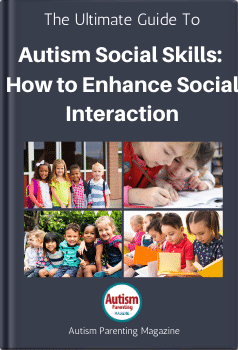To know how to communicate with autistic adults, it’s important to adapt your communication strategies. People with autism spectrum disorders have their own ways of communicating and approaching social interactions, as their communication and language skills may differ from those of neurotypical individuals.
Let’s explore how to use communication strategies to support effective and respectful engagement with autistic people so you can develop closer relationships with them.

Download your FREE guide on
Autism Social Skills:
How to Enhance Social Interaction
1. Use clear and direct language
Communication with an autistic individual should be clear and straightforward.
This is because most autistic individuals will better understand the information provided to them in direct commands or statements.
You should also avoid figurative language, idioms, or sarcasm in any way. These modes of communication often create difficulties in comprehension.
For example, instead of asking, “Could you lend a hand?” you should provide the information as directly as possible. For instance, you could ask, “Can you help me carry this box?”
This clarity can make all the difference in the degree to which they understand and respond.
2. Address them directly
It’s important to get the attention of the person with autism before starting your talk. To do so, start by saying their name so that they know they are participating in something social.
It also represents successful communication. By doing this, you are aiding the person in processing the information in their brain.
For instance, you can say, “John, I would like to ask you something concerning the project,” and then proceed with the question.
This approach keeps the contact personal and, therefore, much more efficient. It addresses the autistic person directly to avoid misunderstandings in communication.
3. Treat them as adults
The autistic adult should be treated with the same respect and appropriateness as their age, aside from their autism diagnosis.
As would be the case with anyone, speaking in a condescending tone or even oversimplifying your language when talking with an autistic individual may be perceived as disrespectful.

Remember: they are adults with thoughts, interests, and experiences. Instead of talking to them as if they were children, the tone should be mature.
By treating the autistic as adults, you will create more room for mutual respect.
4. Be patient and allow extra processing time
Processing information can sometimes take longer for autistic individuals.
To support this, give them time to process what you have said and to be able to formulate a reply. This may be especially helpful in discussions involving abstract concepts or introducing new information.
For instance, when asked a question such as, “What do you think of this proposal?” you should allow a moment of silence before responding.
These may be awkward silences to you, but they help allow space to process information effectively for autistic adults.
Patience helps make the interaction more comfortable and improves communication.
5. Don’t assume a lack of interest based on body language
Body language can look very different in autistic adults from what is generally considered typical in social communication.
A lack of eye contact, minimal facial expressions, or other differences in communication are not signs of a lack of interest.
For example, during a conversation, the autistic adult might look away because of sensory overload or personal space preference but actually is listening.
To address this communication gap, you should pay more attention to their verbal responses or nonverbal forms of communication. For example, nodding can be interpreted as them being interested.
6. Respect their preferred method of communication
People with autism spectrum disorder may have their own communication preferences, writing forms, visual supports, and different forms of communication.
For instance, some only communicate in writing and never make phone calls. Other possibilities include picture communication symbols, letters, or typing.
In this regard, supporting the autistic person’s communication style reduces the sensory overload and comforts both parties during an interaction.
Learning how to communicate with autistic adults fosters connection
Being aware of the communication differences of autistic adults, plus how they approach social interactions, will build positive social relationships based on respect and empathy.
You should always remember to speak clearly, use precise language, and address them directly at all times.
Also, treat them as adults and give them time to process all information.
Instead of watching body language, listen to the words and respect their kind of communication.
These tips will improve the proper understanding of autistic communication and encourage meaningful experiences essential in everyday life.
FAQs
Q: How do you interact with an autistic adult?
A: Approach interactions with respect and openness, using clear language, with attention to their communication style. Patience and understanding support better communication in various social situations.
Q: How do autistic adults communicate?
A: Communication and social skills may vary among autistic adults. Some may prefer verbal over nonverbal communication, while others may use nonverbal or alternative forms, such as an assisting device.
Q: How do you communicate with a nonverbal autistic adult?
A: Respect their preferred method of communication, whether it be through the use of visual aids, writing, or the use of augmentative and alternative communication devices. Do give them time to respond.
Q: How can you connect with an autistic adult?
A: Building rapport involves respecting their communication style, providing emotional support, and being interested in their responses. To do so, you should try to listen actively and be flexible.
Q: How do autistic adults show affection?
A: Autistic adults may express affection in ways that are different from neurotypical people, such as spending time together or sharing interests. Knowing this will help deepen the connection between you and the individual.
References
Cummins, C., Pellicano, E. and Crane, L. (2020), Autistic adults’ views of their communication skills and needs. International Journal of Language & Communication Disorders, 55: 678-689. https://doi.org/10.1111/1460-6984.12552
Forby L, Anderson NC, Cheng JT, Foulsham T, Karstadt B, Dawson J, Pazhoohi F, Kingstone A. Reading the room: Autistic traits, gaze behaviour, and the ability to infer social relationships. PLoS One. 2023 Mar 1;18(3):e0282310. doi: 10.1371/journal.pone.0282310. PMID: 36857369; PMCID: PMC9977004.
Gaynor, Z., Alevizos, K., Butler, J. (2020). Is That Clear? Effective Communication in a Neurodiverse World. United Kingdom: Acrobat-Global.
Haigh SM, Walsh JA, Mazefsky CA, Minshew NJ, Eack SM. Processing Speed is Impaired in Adults with Autism Spectrum Disorder, and Relates to Social Communication Abilities. J Autism Dev Disord. 2018 Aug;48(8):2653-2662. doi: 10.1007/s10803-018-3515-z. PMID: 29500756; PMCID: PMC6041130.
Howard, P. L., & Sedgewick, F. (2021). ‘Anything but the phone!’: Communication mode preferences in the autism community. Autism, 25(8), 2265-2278. https://doi.org/10.1177/13623613211014995
Strömberg, M., Liman, L., Bang, P., & Igelström, K. (2022). Experiences of sensory overload and communication barriers by autistic adults in health care settings. Autism in Adulthood, 4(1), 66-75. https://www.liebertpub.com/doi/abs/10.1089/aut.2020.0074
Zisk, A. H., & Dalton, E. (2019). Augmentative and alternative communication for speaking autistic adults: Overview and recommendations. Autism in Adulthood, 1(2), 93-100. https://www.liebertpub.com/doi/abs/10.1089/AUT.2018.0007



